North America
Explore some of our North American collection at the Horniman in this learning resource.
Explore some of our North American collection at the Horniman – download the resources below, or, if you would like to make your own trails or worksheets tailored to your visit, many of the images and text below (and in our other resources) can be easily copied and pasted to your own design.
- Perhaps use images from objects located in different galleries and in the gardens to create a challenge or simple trail through the Museum to find specific objects or places.
- Use object images to encourage independent research, for instance, find out and write down three facts about an object or a group of objects. Alternatively, give facts or clues and challenge your pupils to identify mystery objects.
- Set an alphabetical challenge to find or draw 26 objects one for each letter of the alphabet.
- Create a sketchbook challenge.

Whalebone club
Clubs like this are some of the most important objects produced on the Northwest Coast. They come from the Nuu-chah-nulth peoples of the West Coast of Vancouver Island, Canada.
Whale hunts could take days, and many crews never returned. One whale could produce enough food to support a community for a year.
Whale hunting was banned in the 1920s as whales had become endangered, although a few special licenses are still granted today. Hunts were very rare and were culturally important, so some viewed the ban as a racist attack on Native communities.
Whalebone clubs were not just weapons but also trophies. They showed that the wearer had gone to sea in a canoe and come back with a whale carcass that had kept his people alive and healthy.
This club has an eagle motif on the pommel, a family crest that connected people with their clan relatives.
Whale hunts could take days, and many crews never returned. One whale could produce enough food to support a community for a year.
Whale hunting was banned in the 1920s as whales had become endangered, although a few special licenses are still granted today. Hunts were very rare and were culturally important, so some viewed the ban as a racist attack on Native communities.
Whalebone clubs were not just weapons but also trophies. They showed that the wearer had gone to sea in a canoe and come back with a whale carcass that had kept his people alive and healthy.
This club has an eagle motif on the pommel, a family crest that connected people with their clan relatives.
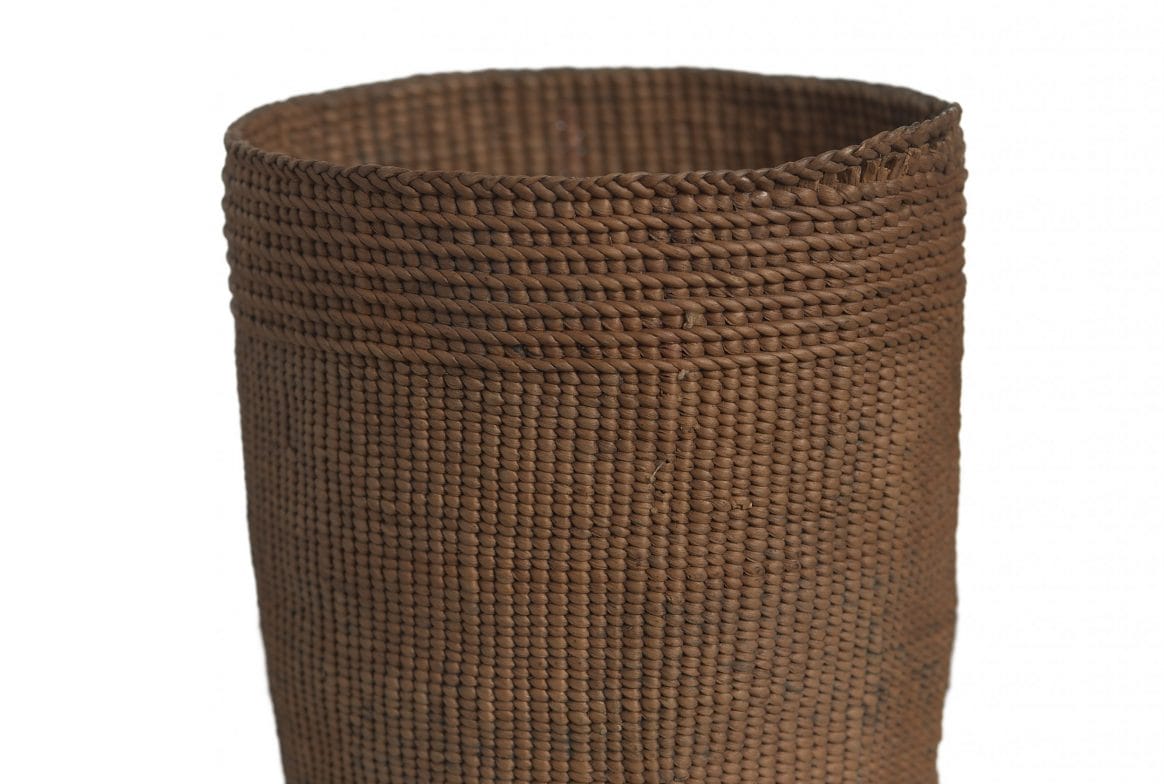
Woven Cup
This basket is actually a cup, made by the Haida people of the Northwest Coast.
The most common and useful material for basket-making was spruce root, a durable material that could be softened and woven into baskets of different sizes and even be made waterproof if it is woven tight enough. Some baskets could even be used to cook soup by adding hot stones to the mixture inside the basket.
Basket weaving was one of the most important arts of the Northwest Coast. Weavers often added designs and images into their baskets by weaving dyed fibres into the baskets, or as here around the rim, changing or doubling the weave to create raised patterns of woven texture.
How many different materials are the cups and bowls in your home made of?
The most common and useful material for basket-making was spruce root, a durable material that could be softened and woven into baskets of different sizes and even be made waterproof if it is woven tight enough. Some baskets could even be used to cook soup by adding hot stones to the mixture inside the basket.
Basket weaving was one of the most important arts of the Northwest Coast. Weavers often added designs and images into their baskets by weaving dyed fibres into the baskets, or as here around the rim, changing or doubling the weave to create raised patterns of woven texture.
How many different materials are the cups and bowls in your home made of?
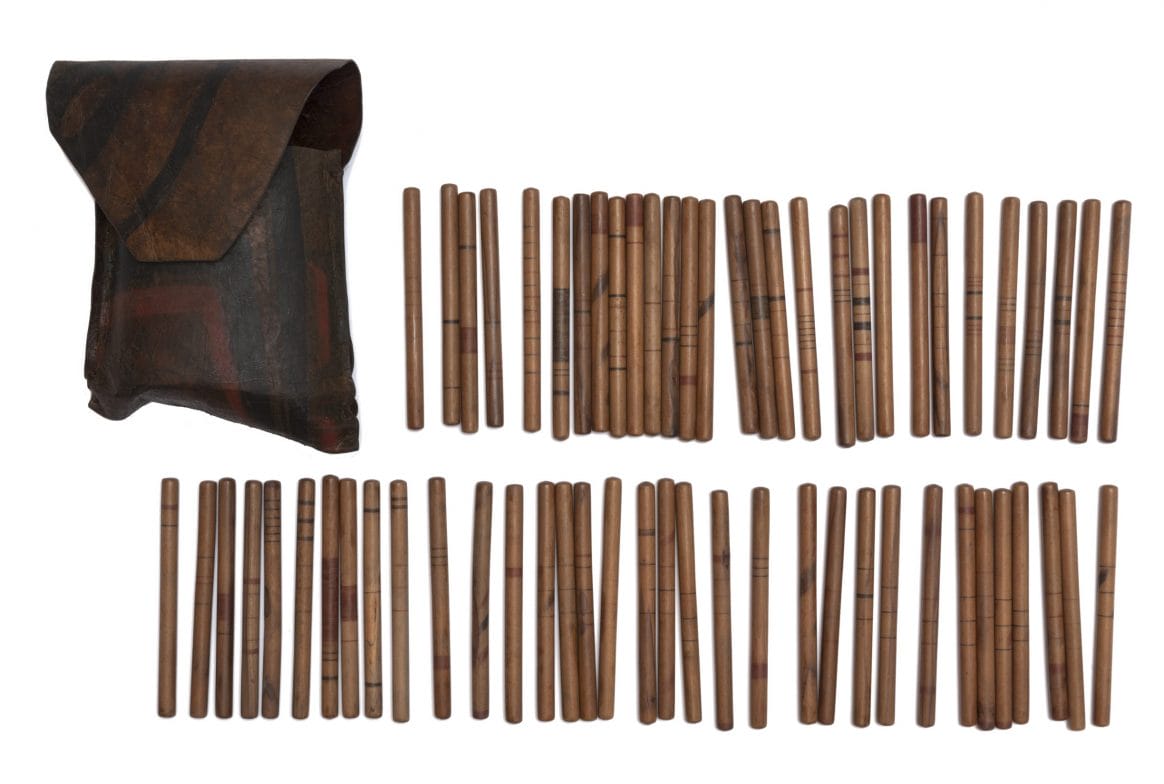
Gambling sticks
The ‘stick game’ refers to a range of games played by the peoples of the Northwest Coast, usually gambling with dice to try to win an opponent’s sticks. The rules vary from place to place but they usually encourage players to trick their opponent or cheat!
There was a strong trading culture along the Northwest Coast and this game would have spread through traders travelling from settlement to settlement. Traders up and down the coast shared a universal trading language. The stick game was not just fun, it helped to teach children to haggle and negotiate – useful skills for a trader.
The stakes were never high in traditional gambling games, but nowadays gambling is big business on Native reservations in the United States, where anti-gambling laws do not apply. Which skills have you learnt by playing a game?
There was a strong trading culture along the Northwest Coast and this game would have spread through traders travelling from settlement to settlement. Traders up and down the coast shared a universal trading language. The stick game was not just fun, it helped to teach children to haggle and negotiate – useful skills for a trader.
The stakes were never high in traditional gambling games, but nowadays gambling is big business on Native reservations in the United States, where anti-gambling laws do not apply. Which skills have you learnt by playing a game?
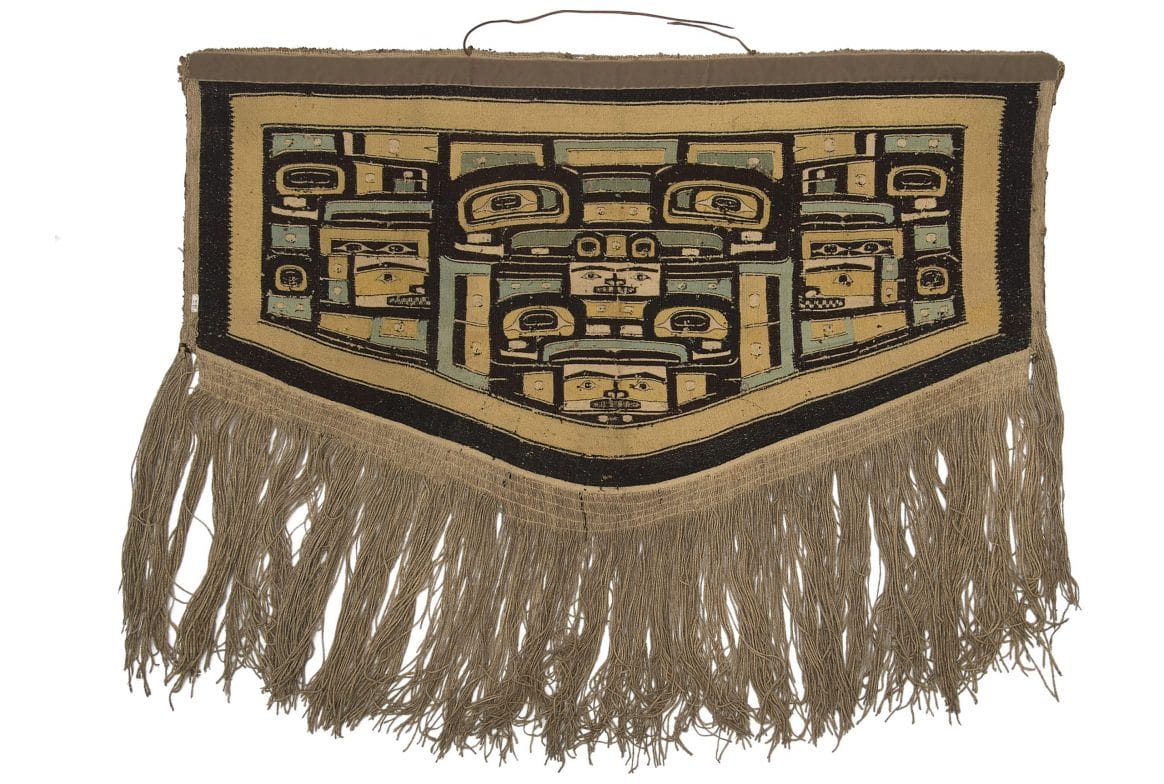
Woollen Chilkat blanket
Chilkat blankets were the dancing robes of high-ranking people of the Northwest Coast in the nineteenth century, and were worn over the shoulders.
This blanket shows a family crest, possibly featuring killer whales. The same crests would have appeared on drums, masks and other family possessions. It is woven out of dyed mountain goat wool spun over a core of cedar-bark string.
The men hunted the goats, created the frame and painted the design, which the women then created - using a form of braided twining, probably the most complicated weaving technique in the world!
One blanket would have taken more than a year to weave. With a garment taking so long to produce, only important members of the tribe could wear it. Some chiefs from the 18th century were buried in their blankets.
Can you think of another culture in which important people were buried with costumes or objects?
This blanket shows a family crest, possibly featuring killer whales. The same crests would have appeared on drums, masks and other family possessions. It is woven out of dyed mountain goat wool spun over a core of cedar-bark string.
The men hunted the goats, created the frame and painted the design, which the women then created - using a form of braided twining, probably the most complicated weaving technique in the world!
One blanket would have taken more than a year to weave. With a garment taking so long to produce, only important members of the tribe could wear it. Some chiefs from the 18th century were buried in their blankets.
Can you think of another culture in which important people were buried with costumes or objects?
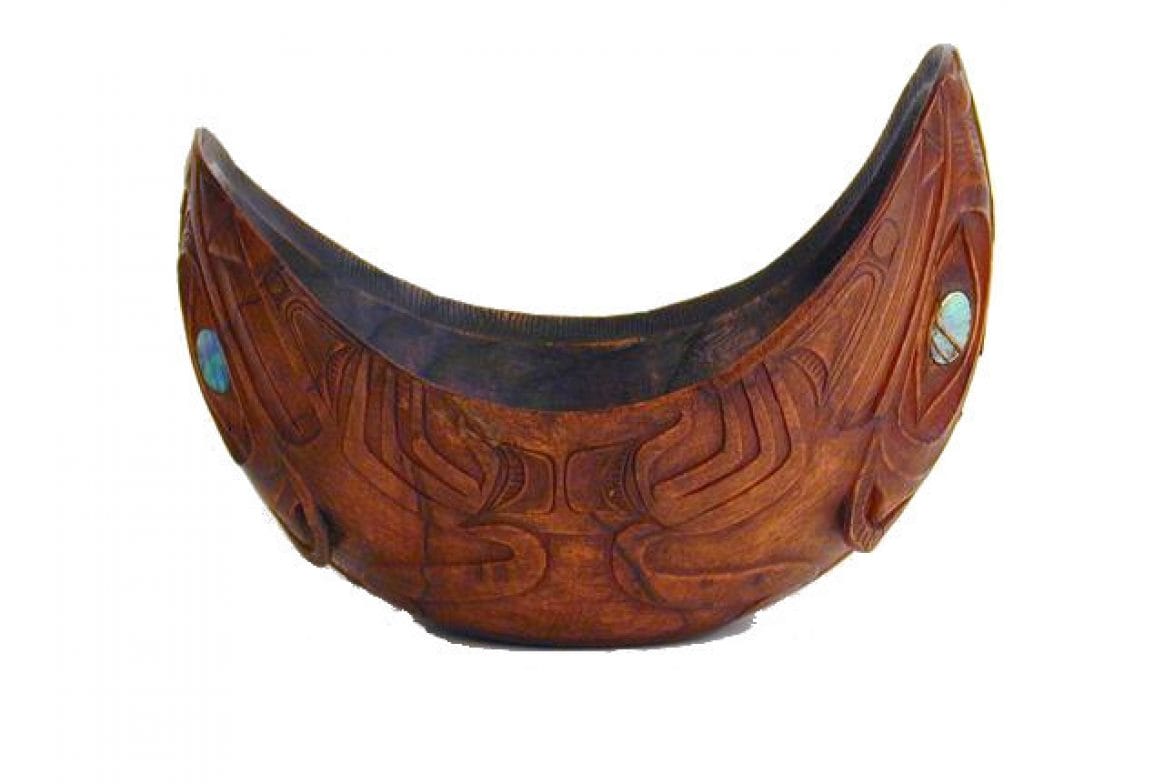
Bowl
Made from mountain goat horn, likely from inland British Columbia, Canada. The horn would have been steamed until it became soft, then shaped and cut. It would have held valuable dishes at potlatch ceremonies.
Potlatch ceremonies were extremely important occasions in Northwest communities where people from all over a region would gather together. They were sometimes planned over many years and could feature music, dancing, storytelling, weddings, funerals, trade agreements, gift giving and contests, as well as an enormous feast. This bowl is inlaid with mother of pearl and depicts an animal, possibly a wolf, the crest animal of its owner. What would you put in an important bowl like this?
Potlatch ceremonies were extremely important occasions in Northwest communities where people from all over a region would gather together. They were sometimes planned over many years and could feature music, dancing, storytelling, weddings, funerals, trade agreements, gift giving and contests, as well as an enormous feast. This bowl is inlaid with mother of pearl and depicts an animal, possibly a wolf, the crest animal of its owner. What would you put in an important bowl like this?
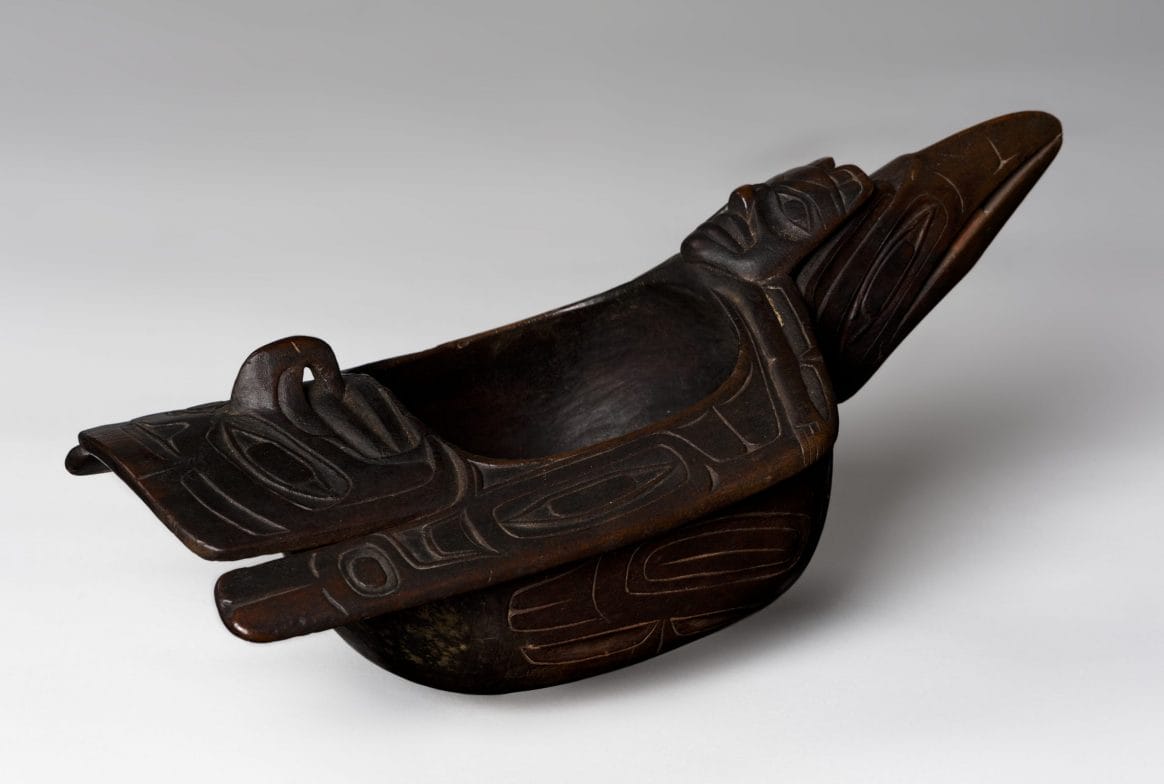
Grease container
Potlatch feasts had a regular dish: oolachen. This butter-like condiment was made from candlefish and highly prized by Northwest communities. It would be handed around at potlatch ceremonies and spoonfuls would be poured over dishes. This dish would have remained on the top table reserved for the most important people at the feast. The grease is so potent that some containers still ooze oil today, often over two hundred years later!
The container features the image of Raven, known in Native communities as a trickster who could bring blessings or curses.
As Europeans moved through North America, they violently suppressed Native cultures in an effort to control the people. Potlatch ceremonies were banned from 1884 until the 1950s – some carried on regardless, but increasingly strict control forced communities to give up their culture.
How might a Native American feel to look at this bowl now?
The container features the image of Raven, known in Native communities as a trickster who could bring blessings or curses.
As Europeans moved through North America, they violently suppressed Native cultures in an effort to control the people. Potlatch ceremonies were banned from 1884 until the 1950s – some carried on regardless, but increasingly strict control forced communities to give up their culture.
How might a Native American feel to look at this bowl now?
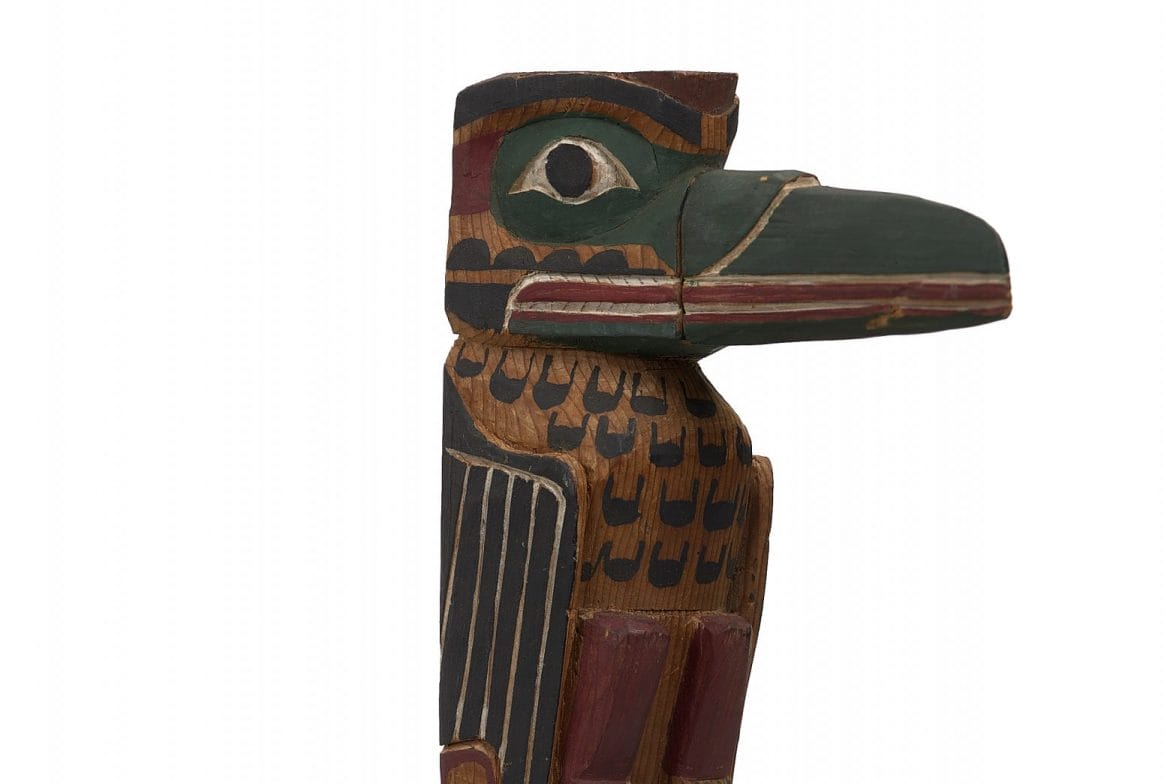
Totem pole
This miniature totem pole was probably made by the Kwakwaka'wakw people of Northern Vancouver Island and British Columbia in the early 20th century. It features a huge bird, Hamats'a, a legendary creature who is said to eat humans and will one day swallow the world!
Europeans banned Native Americans from carving totem poles. They continued in secret, so this miniature could be a forbidden message from the Kwakwaka'wakw people to the wider world.
Full-sized totem poles were created as memorials to ancestors and displayed family legends, and were often placed in front of the house or by coffins of important people. The carvings on the pole showed the animals of the family crest.
Without written language, totem poles were one of the ways in which Native peoples could record stories, legends, and myths through images. What would you carve into your totem pole to represent you or your family?
Europeans banned Native Americans from carving totem poles. They continued in secret, so this miniature could be a forbidden message from the Kwakwaka'wakw people to the wider world.
Full-sized totem poles were created as memorials to ancestors and displayed family legends, and were often placed in front of the house or by coffins of important people. The carvings on the pole showed the animals of the family crest.
Without written language, totem poles were one of the ways in which Native peoples could record stories, legends, and myths through images. What would you carve into your totem pole to represent you or your family?
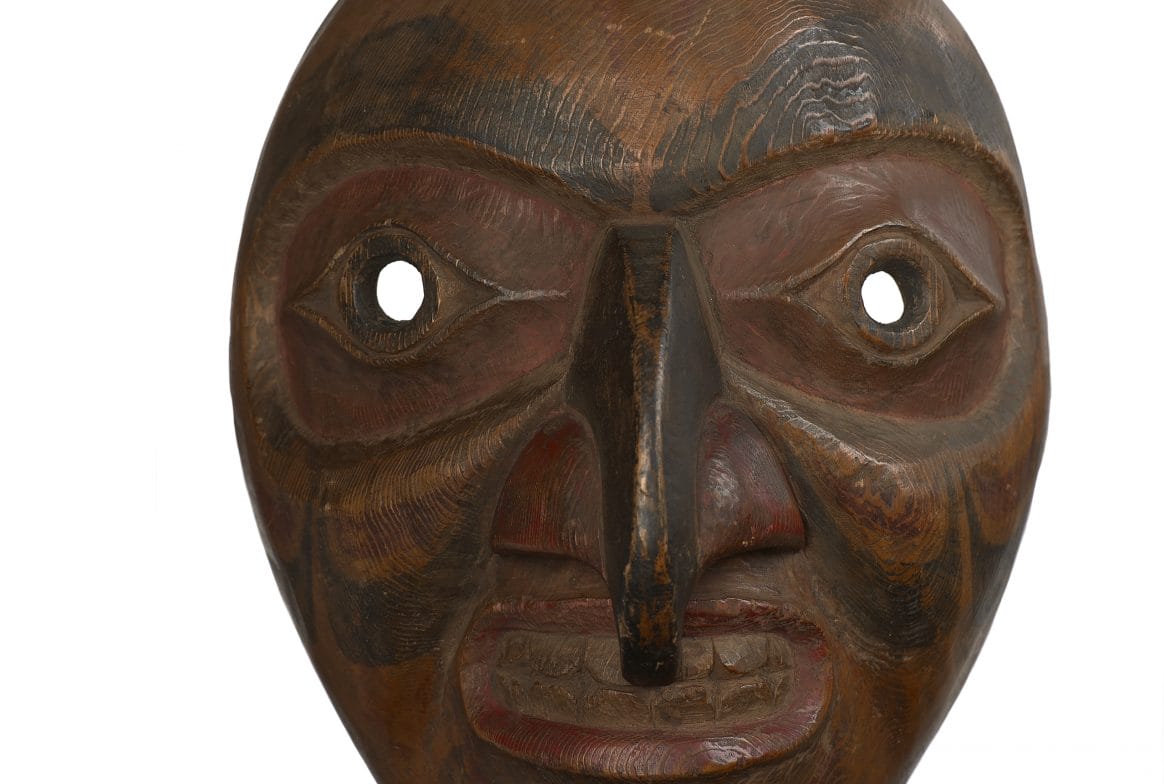
Mask
This mask is carved from yellow cedar wood and probably dates to the late 19th century. It depicts a hawk-man, and would probably have been worn by a Kwakwaka'wakw chief during a potlatch or ceremony.
It marks his association with the hawk clan, and shows how important the hawk was in his history and his life. The face has a long hooked beak in place of the nose with a grimacing human mouth underneath, showing the belief that the wearer would literally become a hawk during the transformation dances.
Masks were inherited or gifted between family members and showed a person’s rank and status in the clan. Can you think of modern-day clothing or accessories that people wear to show their status?
It marks his association with the hawk clan, and shows how important the hawk was in his history and his life. The face has a long hooked beak in place of the nose with a grimacing human mouth underneath, showing the belief that the wearer would literally become a hawk during the transformation dances.
Masks were inherited or gifted between family members and showed a person’s rank and status in the clan. Can you think of modern-day clothing or accessories that people wear to show their status?
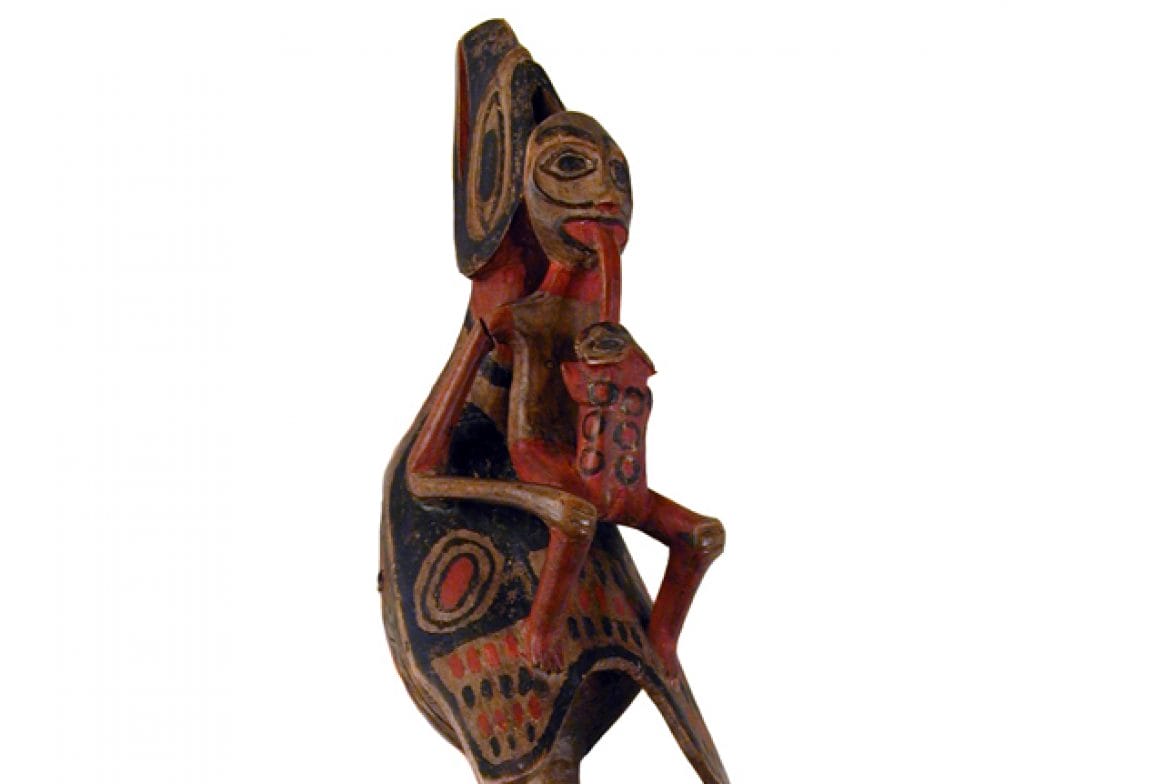
Rattle
Raven rattles were used up and down the Northwest Coast, although the design is thought to have originated among the Tsimshian peoples in British Columbia.
The design varies, but usually shows a raven body with a masked spirit on its back, its tongue reaching for a frog or a bird sitting on the spirit's stomach. Raven was the trickster in Northwest Coast stories, a powerful character capable of bringing great fortune or inflicting great harm.
These rattles were carried by important chieftains and shamans (healers) as symbols of status and authority. They were used at feasts to dramatically accompany masked dancers moving in the firelight. This shaker is made from wood and filled with small pebbles. What other materials could you use to make a shaker?
The design varies, but usually shows a raven body with a masked spirit on its back, its tongue reaching for a frog or a bird sitting on the spirit's stomach. Raven was the trickster in Northwest Coast stories, a powerful character capable of bringing great fortune or inflicting great harm.
These rattles were carried by important chieftains and shamans (healers) as symbols of status and authority. They were used at feasts to dramatically accompany masked dancers moving in the firelight. This shaker is made from wood and filled with small pebbles. What other materials could you use to make a shaker?
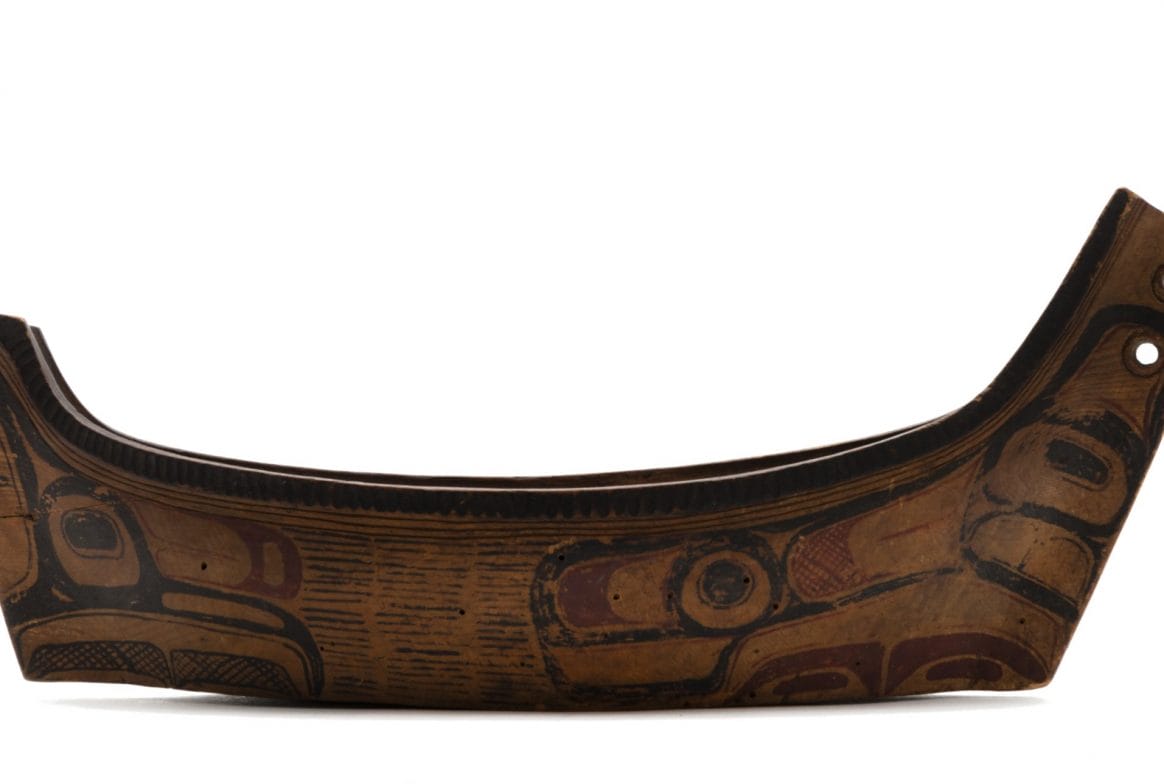
Model canoe
This might look like a toy, but it is a miniature model of a much larger canoe known as a munka.
Canoes of this design were used on the central Northwest Coast in the 18th century. Sometimes known as a war canoe, the high bow probably protected the crew during raiding attacks on defended beaches. However, this would have made the canoe unstable in the heavy seas of the region, and when people began trading rather than fighting in the early 19th century, canoes with a lower bow became more common.
This model was made long after these canoes had fallen out of use, and looks similar to the bowls used at potlatch ceremonies to hold valuable foods and gifts for the guests. It was probably made to look like the historic canoes to remember the history of the potlatch’s chief.
Canoes of this design were used on the central Northwest Coast in the 18th century. Sometimes known as a war canoe, the high bow probably protected the crew during raiding attacks on defended beaches. However, this would have made the canoe unstable in the heavy seas of the region, and when people began trading rather than fighting in the early 19th century, canoes with a lower bow became more common.
This model was made long after these canoes had fallen out of use, and looks similar to the bowls used at potlatch ceremonies to hold valuable foods and gifts for the guests. It was probably made to look like the historic canoes to remember the history of the potlatch’s chief.

Moccasins
These little beaded moccasins were made in the late 19th or early 20th centuries for a child on the Cheyenne reservation in Montana.
Moccasins are the traditional footwear of Plains and Woodlands indigenous peoples. Made from deer hide, they protected the feet but were flexible enough to allow fast, quiet and agile movement when tracking prey. Most moccasins were simple and undecorated, and thrown away when they wore out, but some, such as this pair, were more elaborate and would have been worn for special occasions.
The beads are seed-beads imported from Europe and the colours show the wearer’s tribe and family. They are sewn in strings directly onto the hide, in a system that has sometimes been called ‘lazy stitch’ as it is quicker than attaching each bead.
Traditional beadwork is still practiced today and has even found its way on to modern items such as trainers, baseball caps and lipstick holders.
Moccasins are the traditional footwear of Plains and Woodlands indigenous peoples. Made from deer hide, they protected the feet but were flexible enough to allow fast, quiet and agile movement when tracking prey. Most moccasins were simple and undecorated, and thrown away when they wore out, but some, such as this pair, were more elaborate and would have been worn for special occasions.
The beads are seed-beads imported from Europe and the colours show the wearer’s tribe and family. They are sewn in strings directly onto the hide, in a system that has sometimes been called ‘lazy stitch’ as it is quicker than attaching each bead.
Traditional beadwork is still practiced today and has even found its way on to modern items such as trainers, baseball caps and lipstick holders.
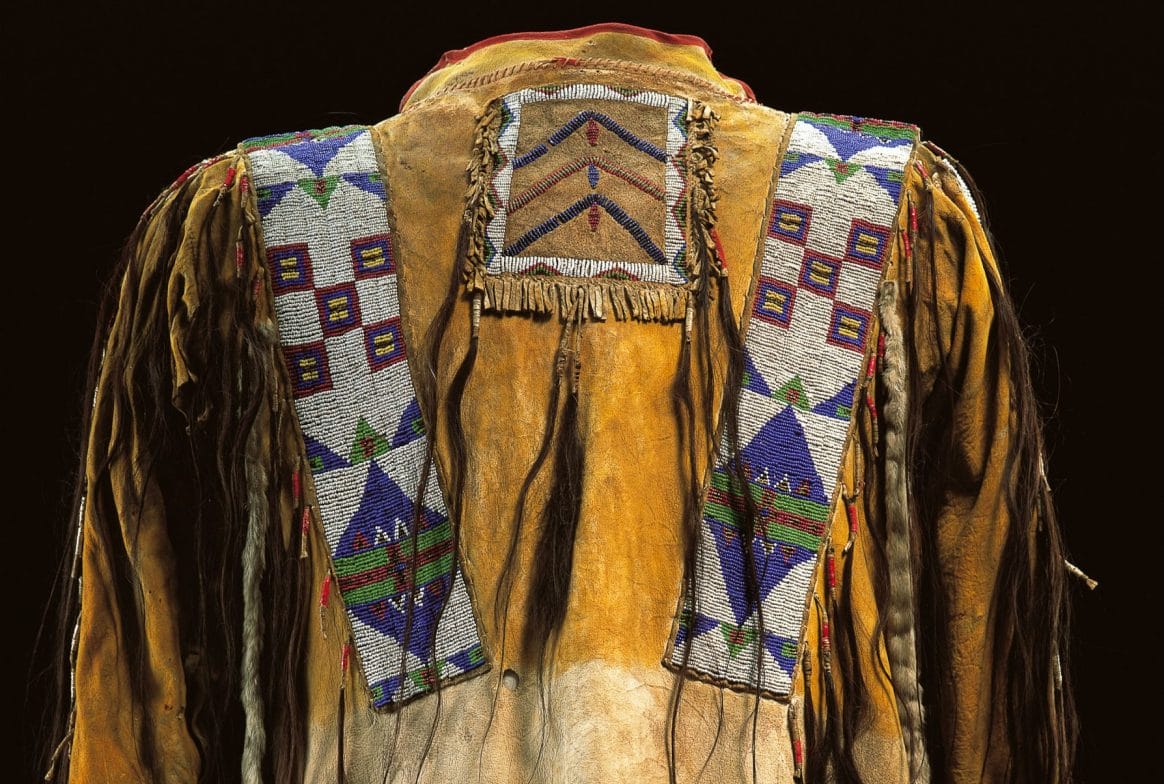
Shirt and trousers
This suit belonged to a warrior of the Dakota people along the US-Canadian border. Men who wore this had proven themselves in battle and become tribal political figures.
With panels beadwork and dyed porcupine quills showing the wearer’s family and tribe, the suit would be worn for ceremonies and pow-wow dances rather than hunting or fighting. The shirt is decorated with scalplocks (a small tuft of hair left on the shaved scalp of a warrior) and horsehair, to show important deeds and bring good luck.
By the 20th century the government had disrupted tribal life by taking land, and traditional items were destroyed or sold.
In the 1920s many Native Americans performed in ‘Wild West shows’, with made-up dances, shooting, riding and mock ‘cowboy and Indian’ battles. Although this was a sad reminder of the past, it did allow Native people a space where traditions were protected from the government.
With panels beadwork and dyed porcupine quills showing the wearer’s family and tribe, the suit would be worn for ceremonies and pow-wow dances rather than hunting or fighting. The shirt is decorated with scalplocks (a small tuft of hair left on the shaved scalp of a warrior) and horsehair, to show important deeds and bring good luck.
By the 20th century the government had disrupted tribal life by taking land, and traditional items were destroyed or sold.
In the 1920s many Native Americans performed in ‘Wild West shows’, with made-up dances, shooting, riding and mock ‘cowboy and Indian’ battles. Although this was a sad reminder of the past, it did allow Native people a space where traditions were protected from the government.

Rifle
This Springfield rifle was produced in Massachusetts for the United States Army in 1878. Rifles like this changed life forever on the American Plains. Earlier firearms were inaccurate and slow, but these were simple, quick and could be fired accurately from horseback. This enabled the US Army to defeat less well trained and armed Native American groups in the so-called Indian Wars. Soldiers and settlers killed large numbers of Native peoples, but they also used rifles to kill American bison, (‘buffalo’) which lived on the Plains in their tens of millions.
After the US government authorised bison hunting on the Plains, up to 50 million bison were killed in less than twenty years. By 1890 less than a hundred survived, causing Native Americans to starve and forcing them to give up their lands to white American settlers and move onto government reservations, where they relied on food rations to survive.
After the US government authorised bison hunting on the Plains, up to 50 million bison were killed in less than twenty years. By 1890 less than a hundred survived, causing Native Americans to starve and forcing them to give up their lands to white American settlers and move onto government reservations, where they relied on food rations to survive.
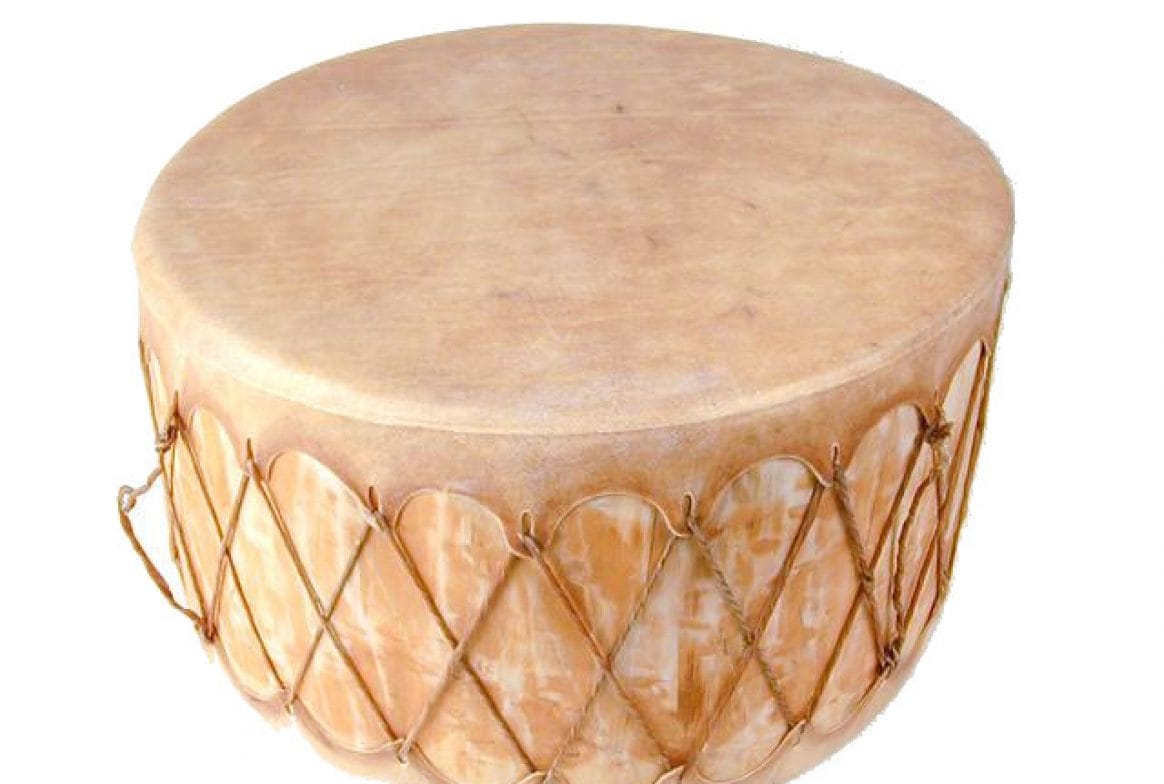
Drum
Being on the move constantly, the nomadic Plains people had to make objects lightweight, robust and easy to repair. This can be clearly seen in their drums, such as this modern example.
Many Native Americans believed that drums were alive and had a body. Drumkeepers had to devote their life to caring for the drum. To the Plains people drums were the most common and important instrument, providing a rhythm to dances and ceremonies that connected people with their ancestors, their history and their land through stories and songs.
This drum is known as a chonchaygah powwow drum, with two elk skins giving the drum double sides and producing a rich, deep sound. Inside are sacred herbs and grasses which gave it extra power and strength. If your family were nomadic (travelling around), what would be your most treasured possession to take with you?
Many Native Americans believed that drums were alive and had a body. Drumkeepers had to devote their life to caring for the drum. To the Plains people drums were the most common and important instrument, providing a rhythm to dances and ceremonies that connected people with their ancestors, their history and their land through stories and songs.
This drum is known as a chonchaygah powwow drum, with two elk skins giving the drum double sides and producing a rich, deep sound. Inside are sacred herbs and grasses which gave it extra power and strength. If your family were nomadic (travelling around), what would be your most treasured possession to take with you?

Baseball cap
This baseball cap is no different to the traditional shirts, belts and moccasins many of us associate with Native American peoples. It is a symbol of tribal identity.
Baseball caps are so called because they originally allowed baseball fans to show which teams they supported. This cap does the same, but in this case the cap shows which tribe the wearer belongs to, rather than which team he or she supports.
It is decorated with an eagle design and red, blue and orange patterns in plastic beads, indicating that it is from the Arapho people, a Plains group now living in Wyoming.
Native American people have not stopped using clothing to express their tribal identity, but have simply blended historical traditions with modern materials and technology. How do you express your identity?
Baseball caps are so called because they originally allowed baseball fans to show which teams they supported. This cap does the same, but in this case the cap shows which tribe the wearer belongs to, rather than which team he or she supports.
It is decorated with an eagle design and red, blue and orange patterns in plastic beads, indicating that it is from the Arapho people, a Plains group now living in Wyoming.
Native American people have not stopped using clothing to express their tribal identity, but have simply blended historical traditions with modern materials and technology. How do you express your identity?















